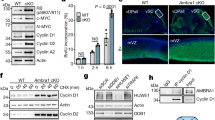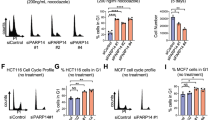Abstract
Sak/Plk4 differs from other polo-like kinases in having only a single polo box, which assumes a novel dimer fold that localizes to the nucleolus, centrosomes and the cleavage furrow. Sak expression increases gradually in S through M phase, and Sak is destroyed by APC/C dependent proteolysis. Sak-deficient mouse embryos arrest at E7.5 and display an increased incidence of apoptosis and anaphase arrest. Sak+/− mice are haploinsufficient for tumor suppression, with spontaneous tumors developing primarily in the liver with advanced age. During liver regeneration following partial hepatectomy, Sak+/− hepatocytes display a delay in reaching the first M phase, multipolar spindles, disorganized tissue morphology and loss of acuity for cyclin B1 expression. Similarly, Sak+/− MEF cells proliferate slowly, and show a high incidence of centrosome hyper-amplification. We suggest that Sak provides feedback to cell cycle regulators, and thereby precision to the switch-like transitions of centrosome duplication and exit-from-mitosis. Sak binds to p53, and studies are underway to provide a molecular context for the Sak-p53 interaction. Animal models of haploinsufficiency and more comprehensive models of cell cycle regulation should contribute to improvements in cancer risk assessment and novel therapies.
This is a preview of subscription content, access via your institution
Access options
Subscribe to this journal
Receive 50 print issues and online access
$259.00 per year
only $5.18 per issue
Buy this article
- Purchase on Springer Link
- Instant access to full article PDF
Prices may be subject to local taxes which are calculated during checkout



Similar content being viewed by others
References
Bai F, Pei XH, Godfrey VL and Xiong Y . (2003). Mol. Cell Biol., 23, 1269–1277.
Barr FA, Sillje HH and Nigg EA . (2004). Nat. Rev. Mol. Cell Biol., 5, 429–440.
Bell DW, Varley JM, Szydlo TE, Kang DH, Wahrer DC, Shannon KE, Lubratovich M, Verselis SJ, Isselbacher KJ, Fraumeni JF, Birch JM, Li FP, Garber JE and Haber DA . (1999). Science, 286, 2433–2434.
Bembenek J and Yu H . (2001). J. Biol. Chem., 276, 48237–48242.
Blagden SP and Glover DM . (2003). Nat. Cell Biol., 5, 505–511.
Brassac T, Castro A, Lorca T, Le Peuch C, Doree M, Labbe J-C and Galas S . (2000). Oncogene, 19, 3782–3790.
Budde PP, Kumagai A, Dunphy WG and Heald R . (2001). J. Cell Biol., 153, 149–158.
Dai W, Li Y, Ouyang B, Pan H, Reissmann P, Li J, Wiest J, Stambrook P, Gluckman JL, Noffsinger A and Bejarano P . (2000). Genes Chromosomes Cancer, 27, 332–336.
Dai W, Wang Q, Liu T, Swamy M, Fang Y, Xie S, Mahmood R, Yang YM, Xu M and Rao CV . (2004). Cancer Res., 64, 440–445.
Elia AE, Rellos P, Haire LF, Chao JW, Ivins FJ, Hoepker K, Mohammad D, Cantley LC, Smerdon SJ and Yaffe MB . (2003). Cell, 115, 83–95.
Elledge SJ . (1996). Science, 274, 1664–1672.
Fernebro E, Halvarsson B, Baldetorp B and Nilbert M . (2002). BMC Cancer, 2, 25.
Ferrell Jr JE . (2002). Curr. Opin. Cell Biol., 14, 140–148.
Fode C, Binkert C and Dennis JW . (1996). Mol. Cell. Biol., 16, 4665–4672.
Fode C, Motro B, Yousefi S, Heffernan M and Dennis JW . (1994). Proc. Natl. Acad. Sci.USA, 91, 6388–6392.
Hammond C, Jeffers L, Carr BI and Simon D . (1999). Hepatology, 29, 1479–1485.
Hartwell LH, Mortimer RK, Culotti J and Culotti M . (1973). Genetics, 74, 267–286.
Hudson JW, Chen L, Fode C, Binkert C and Dennis JW . (2000). Gene, 241, 65–73.
Hudson JW, Kozarova A, Cheung P, Macmillan JC, Swallow CJ, Cross JC and Dennis JW . (2001). Curr. Biol., 11, 441–446.
Initiative TA . (2000). Nature, 408, 796–815.
Jackson RJ, Engelman RW, Coppola D, Cantor AB, Wharton W and Pledger WJ . (2003). Cancer Res., 63, 3021–3025.
Knudson Jr AG . (1971). Proc. Natl. Acad. Sci. USA, 68, 820–823.
Lee KS, Grenfell TZ, Yarm FR and Erikson RL . (1998). Proc. Natl. Acad. Sci. USA, 95, 9301–9306.
Leung GC, Hudson JW, Kozarova A, Davidson A, Dennis JW and Sicheri F . (2002). Nat. Struct. Biol., 9, 719–724.
Lindon C and Pines J . (2004). J. Cell Biol., 164, 233–241.
Lu T, Pan Y, Kao SY, Li C, Kohane I, Chan J and Yankner BA . (2004). Nature, 429, 883–891.
Lucas JA, Miller AT, Atherly LO and Berg LJ . (2003). Immunol. Rev., 191, 119–138.
Ly DH, Lockhart DJ, Lerner RA and Schultz PG . (2000). Science, 287, 2486–2492.
Macmillan JC, Hudson JW, Bull S, Dennis JW and Swallow CJ . (2001). Ann. Surg. Oncol., 8, 729–740.
Malkin D, Li FP, Strong LC, Fraumeni Jr JF, Nelson CE, Kim DH, Kassel J, Gryka MA, Bischoff FZ and Tainsky MA . (1990). Science, 250, 1233–1238.
McNally KP, Buster D and McNally FJ . (2002). Cell Motil. Cytoskeleton, 53, 337–349.
Michel LS, Liberal V, Chatterjee A, Kirchwegger R, Pasche B, Gerald W, Dobles M, Sorger PK, Murty VVVS and Benezra R . (2001). Nature, 409, 355–359.
Muraoka RS, Lenferink AE, Law B, Hamilton E, Brantley DM, Roebuck LR and Arteaga CL . (2002). Mol. Cell. Biol., 22, 2204–2219.
Ouyang B, Pan H, Lu L, Li J, Stambrook P, Li B and Dai W . (1997). J. Biol. Chem, 272, 28646–28651.
Philipp-Staheli J, Payne SR and Kemp CJ . (2001). Exp. Cell Res., 264, 148–168.
Sharon G and Simchen G . (1990). Genetics, 125, 475–485.
Sherr CJ . (2004). Cell, 116, 235–246.
Shirayama M, Zachariae W, Ciosk R and Nasmyth K . (1998). EMBO J., 17, 1336–1349.
Sigrist SJ and Lehner CF . (1997). Cell, 90, 671–681.
Simizu S and Osada H . (2000). Nat. Cell Biol., 2, 852–854.
Su TT, Sprenger F, DiGregorio PJ, Campbell SD and O’Farrell PH . (1998). Genes Dev., 12, 1495–1503.
Takahashi T, Sano B, Nagata T, Kato H, Sugiyama Y, Kunieda K, Kimura M, Okano Y and Saji S . (2003). Cancer Sci., 94, 148–152.
Tarapore P and Fukasawa K . (2002). Oncogene, 21, 6234–6240.
Tarapore P, Okuda M and Fukasawa K . (2002). Cell Cycle, 1, 75–81.
Tsai KY, MacPherson D, Rubinson DA, Nikitin AY, Bronson R, Mercer KL, Crowley D and Jacks T . (2002). Proc. Natl. Acad. Sci. USA, 99, 16865–16870.
Visintin R, Stegmeier F and Amon A . (2003). Mol. Biol. Cell, 14, 4486–4498.
Wolf G, Elez R, Doermer A, Holtrich U, Ackermann H, Stutte HJ, Altmannsberger H-M, Rubsamen-Waigmann H and Strebhardt K . (1997). Oncogene, 14, 543–549.
Xiong W and Ferrell Jr JE . (2003). Nature, 426, 460–465.
Yamashita Y, Kajigaya S, Yoshida K, Ueno S, Ota J, Ohmine K, Ueda M, Miyazato A, Ohya K, Kitamura T, Ozawa K and Mano H . (2001). J. Biol. Chem., 276, 39012–39020.
Yarm FR . (2002). Mol. Cell. Biol., 22, 6209–6221.
Zhang H, Shi X, Paddon H, Hampong M, Dai W and Pelech S . (2004). J. Biol. Chem, 279, 35726–35734.
Acknowledgements
This research was supported by a grant from the National Cancer Institute of Canada to JWD and from the National Colorectal Cancer Campaign to CJS. We thank Jennifer C Macmillan and Carla Rosario for technical contributions.
Author information
Authors and Affiliations
Corresponding author
Rights and permissions
About this article
Cite this article
Swallow, C., Ko, M., Siddiqui, N. et al. Sak/Plk4 and mitotic fidelity. Oncogene 24, 306–312 (2005). https://doi.org/10.1038/sj.onc.1208275
Published:
Issue Date:
DOI: https://doi.org/10.1038/sj.onc.1208275
Keywords
This article is cited by
-
Molecular interactions of miR-338 during tumor progression and metastasis
Cellular & Molecular Biology Letters (2021)
-
Polo-like kinase 4 mediates epithelial–mesenchymal transition in neuroblastoma via PI3K/Akt signaling pathway
Cell Death & Disease (2018)
-
Analysis of centrosome and DNA damage response in PLK4 associated Seckel syndrome
European Journal of Human Genetics (2017)
-
Loss of KLF14 triggers centrosome amplification and tumorigenesis
Nature Communications (2015)
-
A novel role for Plk4 in regulating cell spreading and motility
Oncogene (2015)



